 The sculpture of Maribo in Denmark is the most ancient work of art of the Paleolithic of the North-Europe which is known.
The sculpture of Maribo in Denmark is the most ancient work of art of the Paleolithic of the North-Europe which is known.Maribo (Denmark). Height cm.8.5; widht cm.10,5; lateral anterior view. Kg.0,900 weight.
(This sculpture is introduced with 7 photographies: one from every side and one in semifrontal perspective.) The sculpture represents two human heads joined by the nape. It is completely worked from every side, and does not introduce traces of the original pebble or fragment of rock. The engraving that separates the two heads is carved like every other part of the sculpture. See the drawing (Fig.2) for a easier interpretation.
The analysis of this sculpture is divided in 22 points:
- typology of the representative characterization
- place of finding
- chronology
- typology of the perspective
- physical anthropology
- typology of technology
- intentional portrait
- composition and shape
- typology of the style
- artistic activity
- dress
- religion
- bifrontism
- cults
- rituals
- mithes
- magic of hunting
- magic of fecundity
- symbol
- paleolithic shamanismus
- aesthetics
- science of the Acheuleans TYPOLOGY OF THE REPRESENTATIVE CHARACTERIZATION
It is a two-faced anthropomorphic lithic sculpture, in how much it joins two human heads with an only nape. In the evolued Acheulean two-faced zooanthropomorphic sculptures also exist, in how much they join an human head to one of animal (Fig. 1, 2, 3, 4, 5, 6, 8, 9 ).
PLACE OF FINDING
I have found this lithic sculpture at Maribo in Denmark, in secondary bed: not a "true" paleolithic layer, in how much I have not found lithic tools in associazione.
The findings of paleolithic lithic sculptures found in secondary bed are many. As an example, the Venus of Savignano (Italy) found in 1924, was in an alluvial zone (I made there research in 60's, and there was no trace of lithic tools), and has been attributed from the scholars of paleolithic art to the Aurignacian, for affinity with other small paleolithic feminine figurines with same typology.
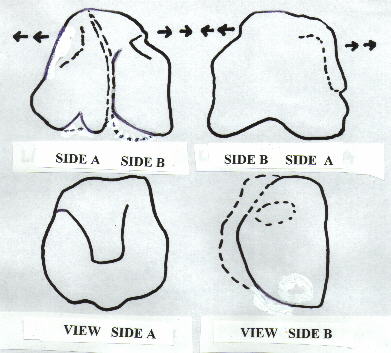
(Drawing in order to better interpret the photographies of the sculpture. The little arrows, in the drawing, are symbolic signs in order to indicate the direction of the look of the two carved heads.) The head (side A) is a FRONTAL REPRESENTATION that has the contours of the face, and the nose in relief, like looks at (Face side A). the eyes are not represented, but the shape of the nose indicates the orbital zone of it. The mouth is not pointed out. The face is wide.
The head (side B) is a SEMIFRONTAL REPRESENTATION, in how much there is the lateral profile, and HALF face in frontal view(Face side B). This type of representation is common in the paleolithic lithic sculpture, where the other half of the face is not represented. A true nose is not represented, but it is deduced from the shape of the profile of the head. The eye and the mouth are constituted from two depressions through a removal of the silex, and are indicative, even if not of good working.
The engraving that separates the two heads(two lines parallels outlined from the bottom towards the high) has been obtained by percussion, and also in order to model the two jaws.
CHRONOLOGY
This anthropomorphic sculpture of Maribo, that I have found in 1977, has been never published, in how much I attributed it to the evolued Acheulean , that is to the final phase of the Lower Paleolithic, and then,it was said that in Denmark the Lower Paleolihic did not exist, in how much the earth was covered from the ice, and therefore, for me it was an insoluble problem. Recently in Denmark the Paleolithic has been dated at 100,000 years, that is at the final phase of the Lower Paleolithic, and therefore I decided to publish it .
Always I am convinced that e convinced that this sculpture is databile to the evolued Acheulean.
As the chronology is based on the cultural phases, and these have the name of the typology of tools.
In Italy the evolued Acheulean, or final, has been developed during the Riss ice age and before 350,000 years ago, but the medium date in use in Italy is 200.000 years. Always in Italy, the successive cultural phase is the Mousterian, dated from 60,000 to 40,000 years ago. However, I am convinced that the man has lived in Denmark, like in Italy. For Denmark the very colds periods can be excluded ; but if the proofs are not found, that is if they are not found tools of the Lower Paleolithic produced previously in the warm period, probably that have had a destruction for produced alluvial tumbling from the marine waves and the mooving glaciers
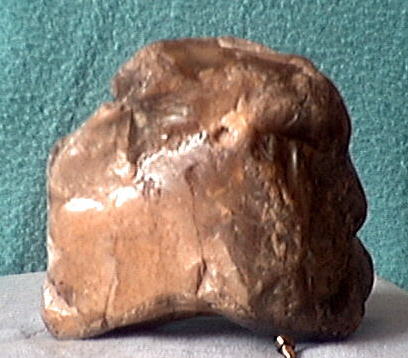
Posterior lateral view of the previous photography Fig.1, and, as such, the side A is on the right, and the side B on the left. In this photography the profiles of the head of the two human types are looked at better, even if this part is less worked, and with little relief. This sculpture, like others of the Paleolithic, was not represented all round, and has different thickness, and varying of shape, and however, in the Paleolithic every head, is never equal from a part like from the other. Near the Aegyptians, the master carved half head, and the scholar carved the other half perfectly equal. The head (side B) has anatomical characters who are similar to those of the preneanderthalians, both for the profile of the face, and for the jaw. This side of the face is completely flat, and not in relief,in how much the head frontally is represented at half.
The head (side A)has anatomical characters which are similar to the presapiens. (Both the preneanderthalians and the presapiens are still hypothetical men.)
TYPOLOGY OF THE PERSEPECTIVE
The perspective is one of the main components of the History of the art; of every age, it has studied the several and different types of perspective vision .
The Greeks had invented in scientific way the " central perspective ", applied to the great pictures; in order to see the perspective, it was necessary to watch them staying in front of the center, in how much, if the pictures were seen from the sides, it was no possible to see the perspective.
In this sculpture of Maribo, in order to perceive the images represented,it is necessary to watch every head in semifrontal perspective vision, otherwise it is no possible to understand totally the shape of every head. (Fig 5 and Fig 9).
If the sculpture is wirled between the hands, we can see it better, but the perspective is always semifrontal.
PHYSICAL ANTHROPOLOGY
If it is true that the evolued Acheulean or final is dated before 350,000 years until to 60,000 years ago, its duration has been of approximately 300,000 years, and in this longest period they have not been found skeletons which indicates to us who was the man or the men of the evolued Acheulean.
The men attributed to this phase from the anthropologists are all hypothetical ; that is, in this phase a process of evolution from the findings of Homo erectus is assumed , dated before 450,000 years ago, through hypothetical types presapiens and preneanderthalian, in order to reach the findings of Homo sapiens neanderthalensis and Homo sapiens sapiens with datings of 40,000-30,000 years. However, it is diffuse opinion of many anthropologists (but it is always a hypothesis) that the man of the evolued Acheulean is Homo erectus.
It is augurable that the anthropology makes reference, in this phase of absence of skeletal findings, also to the representative characteration of human heads of the sculptures of the evolued Acheulean.
The represented human types in these sculptures, on average, always have some features of the head that remember and distinguish Homo erectus, from the Presapiens and the Preneanderthalians, and can cooperate with the hypothetical lines of the evolution that have been made. Moreover, in the case of the two-faced anthropomorphic sculptures, like this of Maribo, the represented human types indicate the contemporaneity of subjects presapiens and preneanderthalians; therefore, in lack of skeletal findings, tens of sculptures can constitute a valid medium of research, much more than, not being be found skeletons until today, difficultly we will find in short time.
The description of the human types of the sculpture of Maribo is in the cues of the photographs.
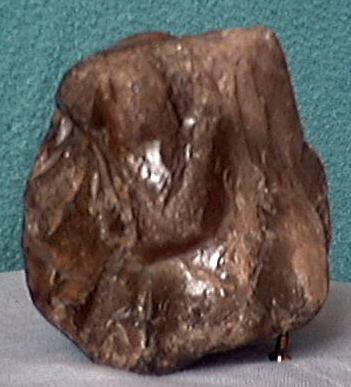
Frontal view of the head (side A) This frontal representation must be considered a face, more than a head. The nose is nearly geometric, and it raises from the bottom, that it is more strait,by enlarging forming an orbital zone that represents the eyes. The thickness of the nose varied from cm. 1 to cm. 0.5. The jaw is wide and with chin, but it could be a man with beard, as it can be deduced from the following photography Fig.6.
Width of face cm. 8.5. Height of the oblique face in cm. 7.5. The removals of the silex concern all the surface of the representation.
TYPOLOGY OF THE TECHNOLOGY
The sculpture of Maribo is completely worked from every part, that is there are no parts of the stone with previous shapes that have been employed.
The technique of detach of the flakes in order to made the represented shape have been made with a tender percussor (wood or bone), but I could not to establish if this technique is of acheulean or clactonian tradition, but, however, the two cultural traditions are often found associated in the paleolithic italian layers .
I publish this sculpture of Denmark in association with a biface tool on pebble of the evolued Acheulean evoluto found in Italy, for showing the working affinity about the removal of the flakes.
The Italian tool (Fig.7) is gained from a pebble, and the technique of removal of the flakes is the much simplest, in how much it is only aimed to make pointed the pebble, and to made it cutting.
The not flaked part of the tool is not the original rind of the pebble of silex; instead the dots that are looked at on the sculpture of Maribo, also this in silex, are the blows from alluvial tumbling on the parts chipped of the same sculpture .
The technique of removal of the flakes in the sculpture and the tool is of the same type and level of qualities, that it corresponds to the same cultural phase.
Also two different, but contemporary, cultural phases, can have the same level of technologic quality.
At the end of the Lower Paleolithic, in several parts of Italy,we find the Acheulean often associated to the Clactonian. These two cultural phases that have been studied only through the tools, are found separated or bound together, and that is: Acheulean, Clactonian or Acheulean-Clactonian. The cultural differences between these types of tools often are conditioned by the existing lithic material in the zone, that is by the size of pebbles of silex or from cliff fragments, with absence or sparsity of pebbles; however, draft of small differences, than made complicated the interpretation.
The quality of the technique of working in the sculpture of Maribo consists in a scale of removals of flakes, that comprises the outline, the shaping and the final touch, that is large, middle and small flakes removed.
The technology for the fabrication of the paleolithic lithic sculptures in kind, and of this of Maribo in particular, is more advanced than the technology for the fabrication of tools. In fact, a great difference exists, is in the working technique, is in the final result.
The removals of material in the pebble or in the cliff fragment in order to manufacture tools, provoke the reduction of the external surface in order to obtain pointed, cutting or scraping tools .
The removals of material in the pebble or the cliff fragment in order to manufacture sculptures, provoke the reduction of both the external and the internal surface.
The removals of the internal surface of the stone in order to model anthropomorphic sculptures, like this of Maribo, demand a technique that is disowned to us, in how much, differently from the fabrication of the tools, the Paleoethnologists have not still made didactic tests for the fabrication of copies; I hope that it will happen soon.
I can only assume, for the fabrication of sculptures in silex, the use of bone or wood chisels, of several dimensions, probably not pointed, that were poigned with a hand, and struck by the percussor with the other hand in order to make sockets and curves under the external surface of the stone.
I want to add that, the use of the microscope, for the control of the working, has been useful for the recording on boneses of animals of works of paleolitica art, and on smallest sculptures and recordings on tender stone, but in the case of the sculpture of Maribo, that is in hard silex, they are worth.
INTENTIONAL PORTRAIT
In the History of the art the portraits of the man have been classified in two types: intentional and fisionomic portrait.
The physiognomyc portrait is the definition of the individual personality, that is what is obtained today with the photography, and is present in hellenistic Greece, for short time near the Romans, and then in the Renaissance in Europe, with the previous of the medioeval portraiting-painting, than is limited to the statues placed on the burials of the died persons.
The intentional portrait, instead, is present near every evolued civilization of the world and in every time.
In the ancient Egypt, the intentional portrait had caught up highest levels of imitation in sculpture that in painting, in fact we can distinguish the blond Lybians of the Cirenaica with blue eyes, and the Asians, the Aegyptians, the Blacks of different ethnies, the Ethyopians and others both for the physic features and the color of the skin, both for the hairdos of hats and the way of dressing.
The same also for archaic Greece, where in numerous celebrative portraits dedicated to the heroes, the model was absolutely conventional.
the two heads of the two-faced anthropomorphic sculpture of Maribo, like all the anthropomorphic sculpture of the Lower and Middle Paleolithic are to be considered "intentional portraits".
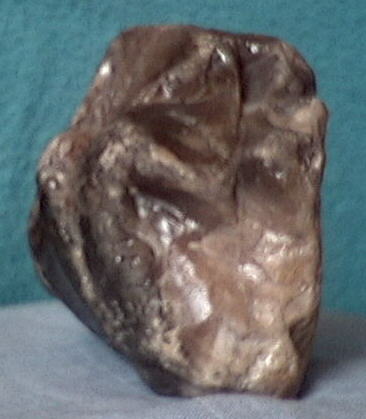
Semifrontal view of the head (side B).
Frontal representation of half human head, that must be observed in semifrontal perspective. Anatomically it is a little increased regarding the proportions of a normal head. See also the drawing (Fig. 2 side B). On the left is looked at the represented profile of the head, while it is not represented on the right. The typology (side B), generally is found in sculptures of single heads, that are in semifrontal relief, and flat on the back.
This head has therefore two formulations of representation that are more important, and that is the profiles of the face, are frontally that laterally.
To the contrary of the other head bound together(side A), in this, the face has little importance in the representation, in how much only a generic orbital zone, and a zone correspondent to the mouth are represented . The maximum width of the face is cm. 6. The height of the face in oblique is cm.10. Every part is well worked through the removal of the material, while the left lateral profile is carved with greater cure, in how much, evidently, thought more important to the aims of the representation.
COMPOSITION AND SHAPE
the anthropomorphic lithic sculpture of the Lower and Middle Paleolithic has various types of representative characterizations: the single head, the head with bust, the two-faced head, where the formulation of the " intentional portrait " is always in semifrontal perspective.
In the figures with body, of which the most known they are that feminine (Venus), in many cases the sculpture is full round, but is absent the feet, the face, and generally arms and hands. However, sure absences and sure presences, are due to technical facts, that vary from zone to zone in the within of the same cultural phase. In some zones where the stone is hard, the Venus has been carved without arms and hands, in other zones where the stone is soft have been carved or recorded, also arms and hands.The composition and the shape increase of quality with the technical progress, that is with the inventions with which the man will have the possibility to produce art with greater details; but this I think is not all, in how many new techniques allow to the man creative searches, with a general increase of quality.
The sculpture of Maribo enters totally in this speech, and this can be understood watching the sculptures of cultural phases that precede the evolued Acheulean.
TYPOLOGY OF THE STYLE
The two heads of the sculpture of Maribo have two various styles, that correspond evidently to two various traditions. One is more realistic (Fig.4 side A) with beard and nose, the other is more idealized (Fig.5 side B). I think that the greater part of the readers will find difficulty to perceive these differences, but is necessary to enter into an engagement, in how much in these searches therefore the elements to analyze are so little, than all must be held in consideration. However, every member of the art of our days, but that it is not superfluous decoration, has its roots in the Lower Paleolithic, therefore if one component lacks, it can be sure found, even if apparently she seems not to exist.
In the interpretation of the paleolithic art it is necessary to hold account of the style, as it happens for the art of every time, without discriminations.
As an example, the painting of the Upper Paleolithic in Europe, Africa and Australia has in common the composition and the shape (even if there are diversity), while the style is completely different from continent to continent. And in Europe, whose art I know well, the style is different from zone to zone, and is differnt in the time also in same zone.
The style is the language of the art, in how much is the way to make art of the time. This is verifiable: between the prehistory, the protohistory, the historical ages and the ethnography there are hundreds of human heads (carved or painted) produced from hundred of different populations, in which the style is always different: much realistic, deformed for lengthening, with abolition or particular attenuation of the face, etc.
For artistic style of a people always we understand the dominant style, as near of a dominant style can survive in traditional shape and minority other styles, destined to estinguish himselfs, or to integrate to the dominant style bringing trasformations.
In the style of the art there is not " quality ", and cannot no more be made comparisons between one and an other civilization . To the observer of today an ancient style can appeals to or it do not appeal to, but it would not have to put in argument the quality of the style. Since the style is the language of the art, it would be like putting in argument the spoken language, that is supporting that the English language is better than that German, or that Japanese is better than that French.
It is necessary to meditate on the two styles of the sculpture of Maribo.
ARTISTIC ACTIVITY
The sculpture of the evolued Acheulean follows a tradition that derives from the previous phases and continues in the successive phases, and can be said the same thing also for the tools; but they are two human activities that have two different traditions at the same time.
The production of lithic tools always has been much copious, in how much, given the usury, the consumption was high, and this is testified from the enormous amount of findings of tools, regarding the found paleolithic sculptures .
It is much probable that the man that manufactured tools, in the within of the same clan, produced at the occurrence also sculptures, and this, is not in contrast with the consideration of two different activities, in how much, these activities will totally develop in two different activities, in post-paleolitic ages .
The working of the stone in order to make tools was a specialization, and in which the most adapted go huntinged, others slaughtered, there was who probably made the tools and the sculptures, etc.
The figure of the artist is important; therefore I want to imagine that when the artist produced a sculpture he was held in high consideration, at least for what the sculpture represented in spiritual field .
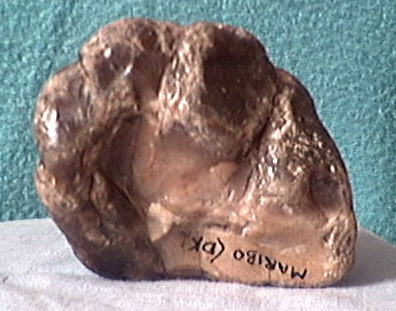
View from under. (the view of this photography is not in the drawing Fig. 2).
This sculpture, like all the paleolithic sculptures, does not have a base like, instead, generally have the sculptures of historical age.
The left part is under of the head of presapiens (Fig. 4 side A). Like looks at, the representation of the jaw is complete, and is grooved under in order to make more obvious all the shape. This jaw is carved with very many cure, and it is represented also the chin, and however, it represents also the beard. The use to hollow out under the jaws in order to evidence the shape, probably is fasten again to the use of conservation of the skull of the died person, that is just empty.
The part on the right of this photography is under of the head of the preneanderthalian (Fig. 5 side B), where the part low, that is flat, corresponds to the part not carved of the half head of the preneanderthalian (Fig. 5) on the right side, while the curve up, always on the right side, corresponds to under of this head, that is to the shape of the jaw of the same preneanderthalian (Fig.5).
DRESS
In the anthropomorphic lithic sculpture of the Paleolithic the dressis a lot reduct.
In the single sculptures of heads are found various types of hairdos , between which a type, enough frequent, of pointed heads, that can be interpreted like a pointed hood or a hairdo of hairs as cone, which moreover is still present in the African ethnography , and in the artistic representations (sculpture, ceramics, painting) in the historical times, in all the continents, except the Australia.
In the paleolithic sculpture men with beard and men without beard are represented, and it is not credible that those without beard, that are in greater number, were all women or young men without beard. Who had a degree of so high civilization to produce sculptures and tools of quality, was sure able to cut the beard.
Also these little elements of the dress must be held in consideration for the study of the physical anthropology and of the culturale anthropology .
The two-faced anthropomorphic sculpture of Maribo represents a head of bearded man, that seems to me a type presapiens, and he is a male (Fig.4 side A), while the other not bearded head, could be a woman, but it is not sure, and to me it seems a preneanderthalian type (Fig.5 side B).
RELIGION
I have always thought that all the paleolithic art was connected to the religion, in way a lot generalized, and without look at possible interpretations, in how much I considered connected to the religion also the cult of died persons.
In archaic Greece the cult of the died person was detached from the religion; and this could be verified also in some period of the Paleolithic, or perhaps in all the Paleolithic.
However the sculpture of Maribo,both more or less connected to the cult of the died person, just like in the case of the ancient Acheuleans, that conserved the skull of the defunct relative, it was or was not a cult connected to the religion, demonstrates that, in both the cases, always existed spiritual rituals, and of group.
BIFRONTISM
In my opinion the two-faced anthropomorphic sculptures of the Paleolithic can be bind to the religion, in how much in the historical periods and in the ethnography the two-faced anthropomorphic representative characterizations always represent divinities.
The bifrontism is one of the more developed topics in the study of the ancient historical religions. However, in the arc of hundred of thousand of years, like in the evolued Acheulean, it is possible that the two-faced anthropomorphic sculptures were detached from the religion in some periods, and connected to other cults, like that one of the died person , or to the celebration of a wedding, or something other.
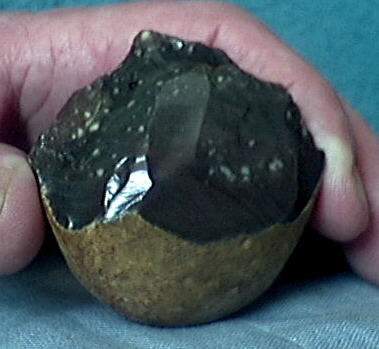
From Rodi Garganico ( Foggia, Italy).
Gained from a pebble of silex. Chipped from the two sides. Measures: width cm. 5.5, Height cm. 5.2. Weight Kg. 0.100. It has the same technique of removal of the flakes of the sculpture of Maribo. Many removals are just equal; but in the sculpture of Maribo, the technique is more refined, with detaches in every direction, and with true and own removals by percussion, and in order to model the shape, what does not exist in the tools, and not even in this.
CULTS
In the Lower Paleolithic, whose duration is of several million years, have not been found burials of the entire corpse, but only of the skulls; except during evolued Acheulean, in which they have not been found no more skulls.
Many scholars have connected these skulls to the cult of the died person, and I share this opinion: even if it has been a lack of findings of 300.000 years in the evolued Acheulean, this cult is continued in the Middle Paleolithic near some neanderthalian people, because other neanderthalians, in various zones, buried the died persons in sleeping position,
The use of conservation of the skull of the defunct relative is continued in the ethnography of Homo sapiens sapiens. In the Lower and middle Paleolithic, a relation between the cult of the skulls and the anthropomorphic sculpture og the only head exists, that indicates that the dimension of every spiritual interest of the man was connected to the only head.
RITUALS
The rituals in the Lower Paleolithic were sure of several types in the course of the year. About the rituals that regard the production of anthropomorphic lithic sculptures we do know nothing, but we have some evidences. the anthropomorphic lithic sculptures of the Lower Paleolithic never have been found in the room places, and not even in the places with high concentration of lithic tools, that generally were near the room places, as it happened in the middle and Upper Paleolithic .
The anthropomorphic lithic sculptures have been found in isolated places, that it is presumed were cult places.
Therefore, presupposing that the finding places were cult places, it follows that in those places they were some rituals with the sculpture.
However, the places of cult (or presumed such)in the Lower Paleolithic are much rare, like the room places, as, generally, the sculptures are found in alluvial layers, transported in confusion by the waters united to tools and detritus of every type.
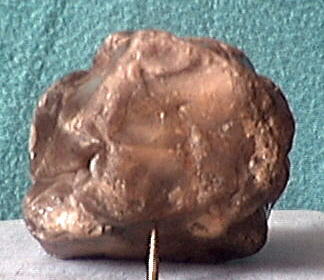
View from the high. (the view of this photography is not in the Fig.2 drawing). THIS PHOTOGRAPHY IS INSIGNIFICANT to the aims of the vision of the representattion of the heads, and is shown in order to show that this upper part is all worked with the removal of the flakes. The left part is the side B, the right part the side A.
MYTHS
The myths are the narration of the facts of the divine, heroic, human world, excluded the fabulous of animals.
The myths are not just of a single individual, but of all people, which in the myth finds expressed its spontaneous vision of the world, the origins of its religious tradition and of its history, the beginnings of its scientific thought.
The artist who has produced the sculpture of Maribo, if had not had his myths and ihs traditions, would not have been in a position to producing a work of so high quality.
MAGIC OF HUNTING
It is a recurrent topic in the interpretation of the paleolithic art, but is not applicable to the anthropomorphic sculpture of Maribo.
MAGIC OF FECUNDITY
It is a recurrent topic in the interpretation of the paleolithic art, but is not applicable to the two-faced anthropomorphic sculpture. Generally, the magic of fecundity magic has been applied to the zoomorphic paintings and the feminine figurines (Venus) of the Middle and Upper Paleolithic.
SYMBOL
In the primitive religions the symbolism is identified with the practice of the magic, has realistic value and is identified practically with the thing that it wants to mean: the totemic rituals, the magical dances, the mimic expressions, the animal disguises are all hidden manifestations and magical that want exactly to mean identification between that is wanted to be represented and the rappresentation itself.
We can assume that the two-faced anthropomorphic sculpture of Maribo (like other sculptures of the evolued Acheulean) has had symbolic use in the rituals.
But the use is not a component of the paleolithic sculpture.
In the sculpture the main components are the sculpted human heads, that can represent men of various types, and this is looked at. That that does not look at, but that we can assume on the base of historical and ethnographic parallelisms, is if this head represents a divinity, or the died person, or something other. But we do known nothing about the use that the man made of these sculptures.
We know instead that the man manufactured some types of lithic tools, employed in order to quarterthe killed animals, to scraper the skins and to cut them, etc.
About the tools, therefore, we know the use, while about the sculptures we do not know
In consideration that, any thing the man produces, must have a use, does not assume a symbolic use in the rituals.
Assuming the symbolic use in the rituals, does not resolve the problem, much more than, not knowing what these sculptures represents , it cannot even be imagined which type of ritual could be. However, the hypothesis of the symbolic ritual excludes the hypothesis of the art for the art.
PALEOLITHIC SHAMANISM
In the ethnography the schaman has the functions of a our priest, but in some cases, for other respects, it has more also, in how much there are schamans that are also doctors, interprets of dreams, who converse with the forces of the nature, etc.
In the evolued Acheulean, given to the high degree of quality in the production of sculptures and tools, and in which a subdivision of the job in the group is sure, is hypothetical the presence of the paleolithic schaman.
Who manufactured lithic tools, manufactured also the sculptures? It is much probable that he was a same persona.
Near the primitive populations the schaman has a student to which he teaches all his knowledge.
In the sculpture as in the lithic tools we see, from the first phases of the Lower Paleolithic to the end of the Upper Paleolithic, to a continuous evolution towards the improvement, even if often in a same zone they are found some lacks or some jolts of quality, which had to migrations or to invasions.
This uninterrupted continuity towards the improvement of the artefacts came handed on from responsible persons that probably were schamans.
It is not therefore to exclude, in numerically small communities, than who produced tools and sculptures, were just the schaman.
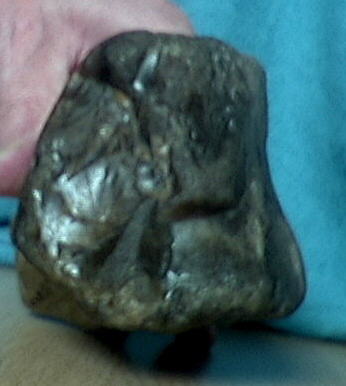
Semifrontal view of the presapiens head (A). It is the same image in semifrontal view of the photography Fig. 4, which instead is in frontal sight. This type of representation, in Italy, has been found also in single sculptures of heads, that are always of frontal type, and that are without lateral profile. However, the vision of this photography is of an light semifrontal perspective, but is better.
AESTETHICS
In the art of every time and place in the historical times are done good works and others made badly. The works good done can be beautiful, or horrible, when it is matter of representations of the death, of monster, etc.
In the prehistoric, protohistoric and primitive art the same rules of the historical times, both in sculpture and in painting, but in evaluating that, if the level of quality is inferior to that one of the historical times, this happened for technical means less improved, in how much not still invented.
The two-faced anthropomorphic sculpture of Maribo is splendid, respect to others of the Acheulean, and the man, that is the artist, with the instruments of which he arranged, could not make better. For a better appreciation, it would have to wirl it between the hands; however, the photographies are exhausting. Undoubtedly, who is not trained in these studies, will sure have difficulty to find in it a minimum of beauty, however it is necessary to deepen also this aspect, that will come developed by the man in the art of the successive periods successivi.
SCIENCE OF THE ACHEULEANS
For science we means also theory and inventions that the technology can realize.
In hellenistic Greece all the machines, that the scientists of the time have invented, could be built.
Leonardo da Vinci (1452 Vinci - Cloux 1519) arrived to put in practice, with his extraordinary abilities of drawing and observer, some of the ideas contained in the ancient hellenistic books: from the study of the hydraulic works, to the anatomy with the dissection of corpses. However, the drawings of Leonardo from Vinci generally represent not realizable objects at his times, because the corresponding technology lacked, in how much the hellenistic technology had gone lost. That means that Leonardo with his drawings has produced art, but not science.
Therefore, as we inquire the origin of the art, it deserves a thought also the origin of science, that has been integrating part in the progress of art.
In every age of the Paleolithic the presence of new technologies, which in previous age were not known, it must be considered like result of the scientific thought, and that is a prescience shape. Although our engagement, in lithic artefact of 300,000 years ago, is not possible to split the scientific contribution of the new invention, from the technology of the time, in how much the scientific contribution is applied directly to the technology, that automatically is improved, and this iboth for the sculpture and for the tools.
However, the inventions taken place in several ways: through the technological progress of a cultural phase compared with the previous ones; the differences of technology between the sculptures and the tools of a same cultural phase; the differences between the several types of sculptures of a same cultural phase; the differences between the several types of tools of a same phase culturale. Between the tools, that are much more numerous of the sculptures, the verification is easier, in how much some types are repeated always equal for long periods, without improvements, because always equally useful to the wished scope, while others come perfected, always as a result of new invention. the progress in the tools happens in order to improve the economic production, while the progress of the sculpture, and the art in kind, happens in order to improve the spiritual life, and subsequently also for decoration and furnishing.

Δεν υπάρχουν σχόλια:
Δημοσίευση σχολίου